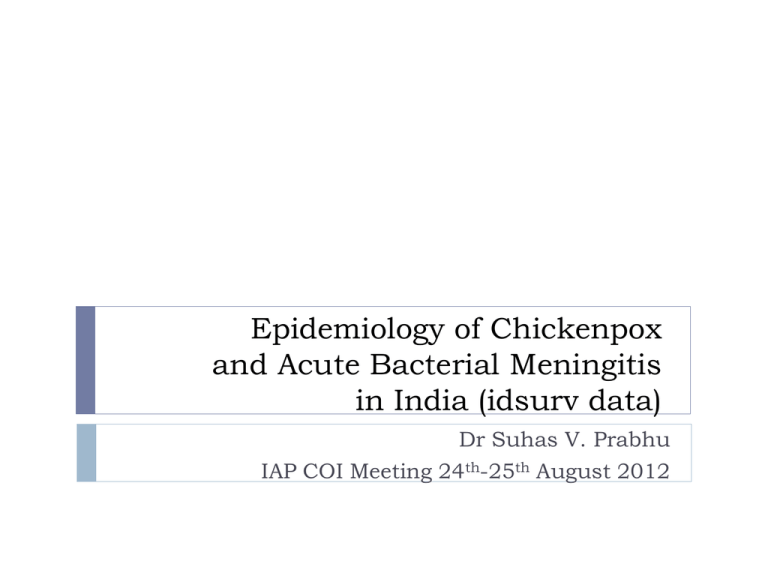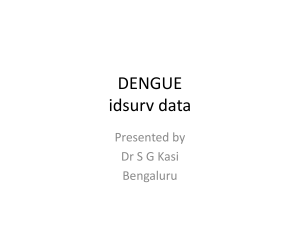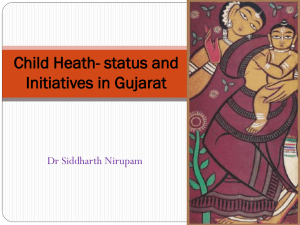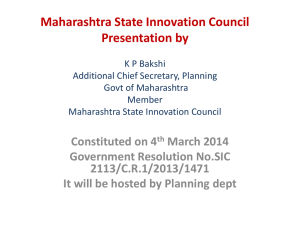
Epidemiology of Chickenpox
and Acute Bacterial Meningitis
in India (idsurv data)
Dr Suhas V. Prabhu
IAP COI Meeting 24th-25th August 2012
Disclosure of conflict of interest
Have received travel grants and honorarium from
On Advisory Board of
Wyeth (Pfizer)
Sanofi Pasteur
Wyeth (Pfizer)
Own shares of various pharma companies
GSK
Cipla
Ranbaxy
The idsurv project data
The Idsurv project data
Data as available from the website is analyzed
Analysis possible and valid for
Age and sex distribution
Seasonal variation
Mortality
Caveats:
Due to selective reporting from doctors, conclusions of
prevalence cannot be made
Numbers are too small for valid statistical analysis
Duration is too short to detect any secular trend
Diagnosis (almost always) clinical so diagnosis may be suspect
Clinical details are few so assessment of the actual morbidity
cannot be made
Chickenpox
Data Collation
Data for 569 days ending August 16, 2012 (~ 1 ½
year)
Data reported by 22 pediatricians in 6 states
Diagnosis was clinical in all cases ostensibly as per the
following case definition:
“Vesicular rash starting on trunk and spreading to
extremities in multiple stages of evolution”
Total 249 cases. i.e. Annual incidence of ~ 160 cases
Age ranging from 1 month to 18 years
Mean age 75 months (6 1/4 years)
153 male, 95 female.
M:F ratio 1.6 : 1
Reporting Pediatricians
Name
District
State
No. of cases
State Total
Rupesh Sheth
Bhimji Sachde
Naveen Thacker
Nitin
Manish Chudasama
J. Kesharani
Vikas Goyal
Tejaskumar Trivedi
Ketan Shah
Sandip Trivedi
Suketu Shah
Arun Shah
Vipin Vasishta
Vijay Yewale
Uday Pai
Tanu Singhal
Harshal Nimkande
Subhash Rao
Pankaj Tardeja
Ashok Gawdi
Sharadkumar Pai-Raikar
Neeta Pole
Kutch
Kutch
Kutch
Kutch
Kutch
Kutch
Kutch
Rajkot
Surat
Sabarkantha
Gandhinagar
Muzzafarpur
Bijnour
Thane
Mumbai
Mumbai
Thane
Thane
Thane
Thane
North Goa
Jabalpur
Gujarat
Gujarat
Gujarat
Gujarat
Gujarat
Gujarat
Gujarat
Gujarat
Gujarat
Gujarat
Gujarat
Bihar
U.P.
Maharashtra
Maharashtra
Maharashtra
Maharashtra
Maharashtra
Maharashtra
Maharashtra
Goa
M.P.
2
112
9
14
1
8
4
1
3
8
22
9
19
21
1
1
8
1
1
2
1
1
184
9
19
249
249
Total
35
1
1
Epidemiology
Reporting states are Bihar, Gujarat, Uttar Pradesh and
Maharashtra (and one case each from M.P. and Goa)
Maximum Cases reported from Gujarat state (184) of
which 150 were from Kutchh district
Seasonal distribution:
Dec to March 116 cases
April to June 116 cases
July to November 17 cases
Crop of cases
March – April 2011
End January to mid-February and May-June 2012
Medical details of Cases
8 patients were hospitalized (3.2%)
Unknown whether the varicella or its complication was
the reason for the hospitalization
No deaths
Immunization status
6 patients were ineligible for immunization (underage)
(ages ranging from 1 month to 6 months)
No cases between 6 and 12 months
Only 2 cases were between 12 to 15 months
36 children were immunized (partially or completely)
17 “fully immunized” and 19 “partially immunized”
Of the 17 “fully immunized” cases specific mention:
One case of having received 1 dose
One child reported to have received 2 doses
Of the 19 “partially immunized” cases specific mention in
5 cases of having received 1 dose of the vaccine
Conclusions from the data
Chickenpox does occur in India
Is a mild disease with no mortality and little morbidity
Higher incidence in boys?
Age distribution moving towards higher side – school age
group is now the commonest affected
Seasonal distribution – In late winter and early summer
Vaccine coverage rates are low – only 36 of the 249
children had received partial or complete immunization
Significant number of “breakthrough” cases after single
dose of the vaccine do occur
Age distribution of cases
No. of cases
160
140
120
100
80
60
40
20
0
<6
6 months 1 year < 15 months 24 months 60 months 144
months < 1 year 15 months < 24
< 60
< 144
months
months months months onwards
More conclusions from the data
Chickenpox is more a disorder of school-going rather than
pre-school children
Only 2 cases between 12 to 15 months; no justification for
reducing minimum age for receiving the vaccine from 15 to 12.
4 % of cases occur in 1st 6 months of life; there is probably
waning levels of antibodies in pregnant women, insufficient to
offer adequate protection to the neonate from trans-placental
transmission.
This might be due to
Immunized in childhood (not suffered natural disease)
Lesser boosting effect from lack of exposure to cases after seroconversion due to reduction in prevalence of chickenpox
Acute Bacterial Meningitis
ACUTE BACTERIAL MENINGITIS
– Case definition
Acute onset of fever (usually > 38.5 °C rectal or 38.0 °C
axillary and one of the following signs: Boggy fontanelle,
seizures, neck stiffness, altered consciousness or other
meningeal signs
WITH
Abnormal CSF
Turbid appearance OR
Leucocytosis (>100 cells / mm3) OR
Leukocytosis (10 – 100 cells / mm3 ) with elevated proteins
>100mg% or CSF sugar <40 mg%
ACUTE BACTERIAL MENINGITIS –
Etiological case definition
ABM Pneumococcal
ABM Haemophillus influenzae
ABM with N. meningitidis
+ve Gram stain / Latex / CSF or Blood culture
ABM other organisms
ABM with H. influenzae
+ve Gram stain / Latex / CSF or Blood culture
ABM Meningococcal
ABM with Strep. pneumoniae
+ve Gram stain / Latex / CSF or Blood culture
ABM with organism other than P/H/N
ABM with no microbial diagnosis
ABM with no microbiological diagnosis
Data Collation
Data for 531 days ending August 13, 2012
(~ 1 yr and 5 months )
Data reported by 9 pediatricians in 4 states
Total 61 cases
Annual incidence = 42 cases / year
Age range 1 month to 16 years
Mean age 39 months (3 ¼ years)
48 male and 13 female
Male : female ratio = ~ 3.7 : 1
Reporting Pediatricians
Name
District
State
No. of cases
State Total
Vipin Vashishta
Bijnour
U.P.
36
36
Rajesh Jasani
Kutch
Gujarat
1
Nehal Vaidya
Smita Tewari
Sandip Trivedi
Vijay Yewale
Jitendra Oswal
Harshal
Nimkande
Sumanth
Amperayani
Kutch
Vadodara
Sabarkantha
Thane
Pune
Gujarat
Gujarat
Gujarat
Maharashtra
Maharashtra
1
1
16
2
2
19
Thane
Maharashtra
1
5
Chennai
Tamil Nadu
1
1
61
61
Total
Epidemiology
Reporting states are only 3: Gujarat, Uttar Pradesh and
Maharashtra (and one case from Tamil Nadu)
Etiology
Pneumococcus
H. influenzae
Meningococcus
“Others”
Unknown
11 cases (18.0%)
2 cases (3.3%)
1 case (1.6%)
13 cases (21.4%)
34 cases (55.7%)
Method of etiological diagnosis
Culture
8 cases
Antigen detection 4 cases
Gram staining
3 cases
Uncertain
17 cases
Proven diagnosis 10 cases
Medical details of Cases
58 out of 61 (95%) were treated as inpatients
3 patients were NOT hospitalized
6 deaths = mortality rate of 9.8 %
H. influenzae 2 cases
Possible reason – Refused admission?
One from Pune, age 8 months, diagnosis by antigen testing,
also had empyema, survived
One from Kutchh, age 12 months, “no microbiological
diagnosis”, survived
Meningococcus 1 case
No microbiological diagnosis, age 13 months, survived
Cases of Pneumoccocal meningitis
Serial No.
Age/Sex
Method of Diagnosis Outcome
Immunized?
1
192/M
?
Survived
No
2
8/M
?
Died
No
3
96/M
?
Survived
Partially (?)
4
84/M
Culture
Survived
No
5
2/F
?
Survived
Partially (?)
6
84/M
?
Survived
No
7
144/M
Culture
Died
No
8
192/M
Gram stain + antigen+
culture
Survived
No
9
23/F
?
Survived
Partially (?)
10
15/F
Gram stain + antigen
Died
No
11
32/M
Culture
Survived
Partially (?)
Immunization status
Of the 11 cases due to Strep. Pneumoniae:
Of the two cases with H. influenzae meningitis:
7 were not immunized
4 were “partially immunized” (No details available)
Outcome in these 4 cases: All survived
Of the 7 unimmunized cases, 3 died
Both were unimmunized
The one case of Meningococcal meningitis:
Not immunized
Conclusions from the data
Acute bacterial meningitis does occur in India
Occurs right from newborn period to adolescence
Higher incidence in younger age group with mean age
being 3¼ years
Higher incidence in boys?
Complete microbiological diagnosis is rarely available
Pneumococcus is reported as the cause in 18% but
diagnosis is confirmed in less than half of the cases
Gram negative organisms are commonly seen esp. in
younger infants
Haemophilus and Meningococcus identified sporadically
Conclusions from the data (contd.)
None of the cases had reported receiving the full course
of vaccines for Pneumococcus or Haemophilus
4 of the cases with Pneumococcal meningitis had been
“partially immunized”
All these 4 survived vs only 4 out of the 7 who were not
immunized (? Partial protection?)
Among the survivors there is no data about the nature of
handicap if any
Thank You!








